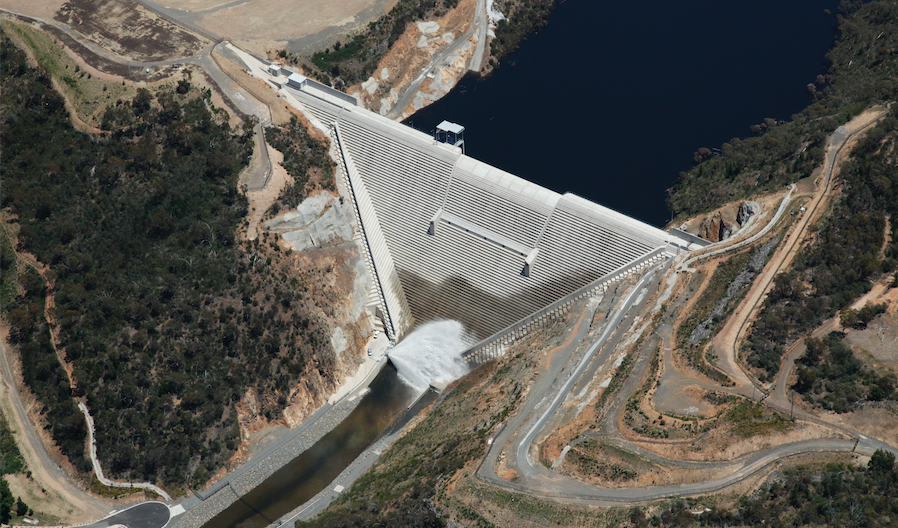
Three of the four main dams of Canberra, the Cotter, Corin, and Bendora are all sitting at 100 per cent capacity…. so much water; where has it all come from? NICK OVERALL takes a look.
SITTING behind the huge concrete dams of Canberra right now is around 270 billion litres of water, or the equivalent of 100,000 Olympic-sized swimming pools.
Three of the four main dams of Canberra, the Cotter, Corin, and Bendora are all sitting at 100 per cent capacity.
Googong Dam, upstream from Queanbeyan, is the only one holding below its full capacity at 95 per cent.
It’s a remarkable difference when compared to this time last year.
Icon Water, the ACT government company that owns and operates the dams, says that following a hot summer and two of the driest years on record, last February saw the dams below 45 per cent.
So where’s all this water coming from?
According to the Bureau of Meteorology (BOM), over the last 12 months Canberra has experienced above average rainfall.
That’s been topped off by the La Niña weather event that brings warm water to the surface of the Pacific Ocean and creates more clouds and subsequently more rain.
Stats from Icon Water show this rainfall peaked in October at 133.6mm, more than doubling the normal average for the month of 59.5mm.
Icon says the last time the dams were at 100 per cent capacity was November, 2016.
Before this it was in 2012, spurring an upgrade to the Cotter Dam, which would see its capacity increase to hold 76 gigalitres, about 20 times its original size.
For reference, a gigalitre consists of one billion litres.
So when there’s this much water hanging around, where does it all go?
A winding network of waterways carries it all down the Cotter River. Starting its spill from the Corin Dam, the water stops off at Bendora and Cotter dams on its way down to the Murrumbidgee River, the second longest river in the country.

When the Googong Dam is at capacity, it spills into the Queanbeyan River and then flows down on to the Molonglo River upstream of Lake Burley Griffin, which also eventually makes its way into the Murrumbidgee. And somewhere along the journey that water has to get turned into the renowned, tasteless liquid Canberra has become famous, and even won national awards for (yes, water-tasting awards are a thing).
That’s done by four storage reservoirs sitting along the Cotter and Queanbeyan rivers that catch raw water then extracted by Icon.
The water is made drinkable through either the Mount Stromlo or Googong water-treatment plants. It then travels through an intricate network of pipes stretching over 3000km, and to one of 48 service reservoir sites throughout the region. From there, it finally makes its way into a glass to be drunk when the tap is turned on.
Although the gigantic concrete walls are the only thing sitting between Canberra and hundreds of billions of litres of water, Icon says the dam system isn’t for flood mitigation, but rather to provide secure drinking water to Canberra and Queanbeyan.
However, Icon says that simply by being dams upstream of the city areas, they help prevent the severity of floods if such events are to occur. The 2010 floods of Queanbeyan, which saw the city centre submerged in 8.4 metres of water and caused over $1 million of damage, could have been much worse if not for the Googong Dam.
“When they are full, our dams can significantly reduce the risk because water typically leaves the reservoir at a slower rate than it enters.?This reduction in peak flow mitigates flood damage downstream,” says Icon. According to Icon, Canberra currently uses around 150 million litres of water a day, and much of that adds up from places many people might not realise.
A dripping tap alone can use between 30-150 litres per day. A sprinkler can use 1000 litres an hour.
Who can be trusted?
In a world of spin and confusion, there’s never been a more important time to support independent journalism in Canberra.
If you trust our work online and want to enforce the power of independent voices, I invite you to make a small contribution.
Every dollar of support is invested back into our journalism to help keep citynews.com.au strong and free.
Thank you,
Ian Meikle, editor




Leave a Reply